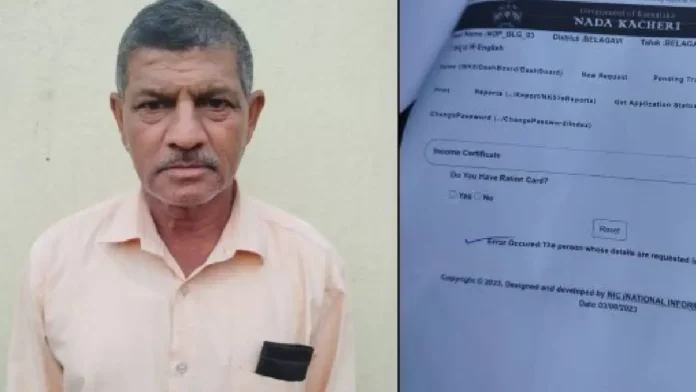Clerical Error Declares 62-Year-Old Dead in Belagavi, causing him to fight an uphill battle to reclaim his identity. Ganapati Kakatkar, a 62-year-old resident of Savgaon, found himself in a shocking predicament when he was mistakenly declared dead in official records. This error occurred during a land succession process, leaving him scrambling to prove his existence to regain his legal rights and dignity.
Ganapati, holding his death certificate, approached Belagavi’s Deputy Commissioner, Mohammad Roshan, to rectify the mistake. The error has had a devastating impact on his life, stripping him of basic rights, including property ownership and access to essential services. His struggle showcases the deep flaws in India’s bureaucratic systems, where a single clerical error can turn someone’s life into a nightmare.
The Far-Reaching Consequences Of Clerical Errors
Being officially declared dead has wide-ranging implications for an individual. Ganapati’s legal existence was effectively erased, barring him from accessing his bank accounts, pensions, and social security benefits. Furthermore, this error complicated matters of property inheritance, as his land and assets were at risk of being redistributed.
Such errors highlight the fragility of bureaucratic processes in India, which often rely on outdated and fragmented record-keeping systems. Incorrect death records, once issued, create a ripple effect of legal and administrative hurdles, forcing victims to go through an arduous journey of affidavits, witness testimonies, and approvals to correct the records.
Ganapati’s case is far from unique. Over the years, India has witnessed multiple instances of individuals declared dead by clerical mistakes or even intentional fraud during property disputes.
Historical Cases Of Declared Deaths
Ganapati’s predicament echoes other infamous cases where individuals had to fight lengthy battles to prove they were alive. One of the most notable examples is Lal Bihari from Uttar Pradesh. Declared dead in 1976 as part of a conspiracy to seize his ancestral property, Lal Bihari spent nearly two decades navigating India’s bureaucratic maze to prove his existence. His efforts brought national and international attention to the issue of fraudulent death declarations.
Another case is that of Abdul Hameed from Bihar, who was declared dead by corrupt officials involved in a property dispute. Like Ganapati, he endured years of frustration, humiliation, and legal battles to restore his official identity.
These stories highlight a persistent issue in India’s administrative systems: the lack of checks and balances in updating sensitive records.
The Systemic Issues Behind The Errors
The root cause of such errors lies in the fragmented and outdated record-keeping practices still prevalent in many parts of India. Often, death certificates are issued without thorough verification, leaving room for mistakes and even deliberate fraud. Additionally, the lack of integration among various government databases makes it challenging to identify and rectify these errors efficiently.
Ganapati’s case underscores the urgent need for administrative reforms. A robust system that prioritizes digitalization, cross-verification, and accountability could significantly reduce such incidents. For instance, Aadhaar-linked record-keeping could streamline processes and ensure accurate updates to sensitive data like death and birth records.
Ganapati’s Fight For Justice
Ganapati’s journey to prove he is alive has been anything but easy. To correct the error, he must provide legal affidavits, gather witnesses, and navigate through layers of bureaucracy. Despite his determination, the process remains slow, highlighting the inefficiencies in the current administrative system.
The emotional and psychological toll on Ganapati is immense. At the age of 62, instead of enjoying his retirement, he is forced to fight for his existence. Local residents and activists have come forward to support him, amplifying his story to pressure authorities to act swiftly.
His case raises critical questions about the accountability of government officials who make such errors. Currently, there are no strict penalties for negligence in record-keeping, leaving victims like Ganapati to bear the brunt of the consequences.
The Need For Systemic Reforms
Ganapati’s struggle serves as a wake-up call for India’s administrative machinery. To prevent such incidents in the future, several reforms must be implemented:
- Digitalization Of Records: Centralized and digital record-keeping systems can significantly minimize clerical errors and fraudulent activities.
- Mandatory Cross-Verification: Introducing stringent verification processes for issuing and amending critical records like death certificates.
- Accountability Mechanisms: Holding officials accountable for errors and negligence through penalties and monitoring systems.
- Awareness Campaigns: Educating citizens on their rights and the procedures to rectify such errors promptly.
These measures are essential not only to ensure the accuracy of government records but also to restore public trust in the system.
The Human Cost Of Bureaucratic Errors
Ganapati’s case is a stark reminder of the human cost of administrative inefficiencies. While the error might seem like a simple clerical oversight, its repercussions have disrupted his life entirely. From financial losses to emotional trauma, the ordeal has left a lasting impact on his well-being.
For Ganapati, the fight is not just about correcting a mistake—it is about reclaiming his dignity and identity. His story resonates with countless others who have faced similar challenges, shedding light on the urgent need for administrative reforms in India.
Ganapati’s determination to prove his existence is a testament to the resilience of individuals let down by the system. As he continues his battle for justice, his story serves as an inspiration and a call for systemic change to ensure no one else has to endure the same fate.



